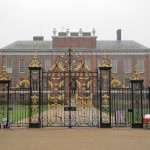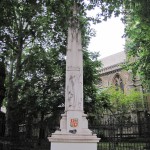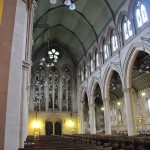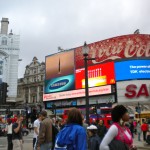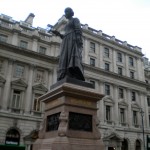August 26th, 2010 · 1 Comment
This afternoon, we saw more of London than we bargained for. Our goal for the assignment was to visit the Kensington High Street (KHS) Tube stop; our navigational skills are clearly wanting at this stage in the game, as an 8 mile round trip took nearly two hours. The following is a recap of our jet-lagged travels.
We managed to go the wrong way out of the front door of the Arran House, as our goal was to take the Circle Line from the Euston Square stop to the KHS one. A genius plan, as we could cover the requirement to take a different route there and back by circumnavigating the Circle in opposite directions. Alas, that would have required making a left out of the Arran House. We made a right. We ended up stumbling on to the Tube at Tottenham Court Road, which could have been an only slightly shorter Tube trip. Fortunately, construction at the Bank stop thwarted our plans, and we took the Central Line all the way out to Liverpool Street before finally connecting to the Circle. Conservatively, this foray took 40 minutes. We took the simpler (and quicker) return path of the Circle back to Euston Square.
Unless it is indeed not as obvious as we think, the KHS station is named for the nearby Kensington Palace and Gardens. The Tube presumably stops there because the surrounding area is an upper class shopping district. The American supermarket Whole Foods, typically found in wealthier locales in the states, had a massive store right down the street from our stop. It is located in the Royal Borough of Kensington and Chelsea.
On our way to Kensington Palace, we stumbled upon a war monument dedicated to the men from Kensington who died in “The Great War.” The monument was situated just outside of an old church, St. Mary Abbotts. St. Mary is a Victorian building in the English Gothic revival style. (A church has been on that site since the 9th century.) Leaving, we got directions (albeit quite circuitous ones) to the palace from a church attendant. Our time was cut short in exploring the area around the palace and its gardens because of the rain. However, we did stumble upon the Romanian Embassy.
Who was on the street? Well, in our brief and informal survey of the neighborhood, there were a lot of pigeons, haughty rich people, tourists, and improbably, two policemen armed with automatic weapons and sidearms. (They followed us for almost two blocks). The area of the neighborhood that we walked in was largely a upper-middle-class shopping district; residences were not readily noticeable. The architecture was an eclectic mix of what appeared to be Victorian-era buildings and more modern stereotypical shopping centers.
Overall, it was quite an enjoyable adventure, despite the rain and the initial issues with the Tube.
Tags: 2010 Dennis · 2010 Stephenie
August 26th, 2010 · 1 Comment
Professor Qualls assigned us Piccadilly Circle. The hardest part was figuring out what Tube station to start from – we didn’t know what was the closest to the Arran Hotel, so that took a little bit of aimless walking around Tottenham Court Road (not that we’ce complaining). It was the Goodge Street station we were after, and we think that being able to find it will be useful before long.
Matt spent the summer in New York City, and Mary Kate has used the New York subway on occasion, and neither of us has ever seen anything quite like the Tube. Its walls are plastered in colorful ceramic tile – untainted by graffiti – and the advertisements lining the walls of the railway promote opera and theater. In speaking of opera, the performers trying to make money in the subway seem to have a different repertoire here: we heard an opera singer and soft-rocker on a keyboard in our stations today. The Goodge Street station also featured a winding staircase of 136 stairs – we were surprised when we expected to run down two flights as a quicker alternative to the lift.
We took Goodge to Tottenham Court Rd, and from there we transferred to the Piccadilly Line at Leicester (pronounced “Lester”?) Square. None of our rides on the Tube were longer than 90 seconds, and every time we found our platform, the Tube train was already waiting for us. (The instant train access was another thing we weren’t used to from American subway systems.) When we climbed out of the Piccadilly Station, named for the Piccadilly Circus, and into the City of Westminster, we felt a world away from Gower Street. “This is the Times Square of London,” Matt immediately remarked. Flashing lightbulbs, MacDonald’s advertisements (and stores), punk rockers with orange spiked hair posing for pictures (for a few quid), and plenty of traffic made us feel more like we were in an American city than we have felt yet. The architecture of the buildings , though– on the second level, above the franchise coffee shops and tourist-y clothing stores – reminded us we were in London: regal brick and stone with ornate facades, often topped with statues or domes lined the streets in all directions. Several tourists asked us to take their pictures in front of statues, and we spotted a few posing outlandishly in front of fountains.
Our favorite memorial statue in Piccadilly Circus was a little further away from the hustle and bustle surrounding the central fountains and monuments. We gravitated toward the Crimean War memorial. (Although it should be noted that actually getting across traffic to reach the memorial is much easier said than done.) It featured a statue of Florence Nightingale, where people continue to leave bouquets of flowers in her honor.
Getting back to the Arran House (even in our fog of jet lag), proved to be a snap. We took a different route – Piccadilly to Oxford Circus to Tottenham Ct. Rd. and a three-block walk home – and got to see a few pubs and store fronts we missed the first time around.
Tags: 2010 MaryKate · 2010 MatthewG

